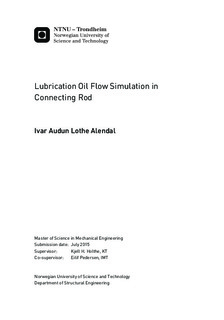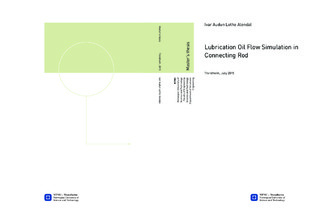| dc.contributor.advisor | Holthe, Kjell H. | |
| dc.contributor.advisor | Pedersen, Eilif | |
| dc.contributor.author | Alendal, Ivar Audun Lothe | |
| dc.date.accessioned | 2015-10-30T15:00:28Z | |
| dc.date.available | 2015-10-30T15:00:28Z | |
| dc.date.created | 2015-07-11 | |
| dc.date.issued | 2015 | |
| dc.identifier | ntnudaim:13351 | |
| dc.identifier.uri | http://hdl.handle.net/11250/2358836 | |
| dc.description.abstract | Lubrication oil-flow in the crank system of an medium size diesel engine running at 750 RPM was modeled and analyzed. The model was built up by combining models from several studies in both engine lubrication systems and pipe flow modal analysis. The model is first used to analyze a system where the oil supply lines are fully open during the complete engine cycle. The result showed that these designs need a very high oil supply pressure to maintain a positive pressure in the connecting rod at all times. Having a positive pressure is important to prevent cavitation in the oil channels, and to ensure a continuous flow of cooling oil. Secondly the model was used to analyze a system where the big-end bearing tracks runs only half way around the circumference, closing the flow when the piston is in the BDC region. Such a design allowed for a lower oil supply pressure, as the channel closes when the oil is forced back. However pressure transients were amplified by the opening and closing procedure. By trimming design parameters, it was possible to reduce the severity of these transients. Various suggestions are discussed in controlling the pressure peaks that occurs. | |
| dc.language | eng | |
| dc.publisher | NTNU | |
| dc.subject | Produktutvikling og produksjon, Industriell mekanikk | |
| dc.title | Lubrication Oil Flow Simulation in Connecting Rod | |
| dc.type | Master thesis | |
| dc.source.pagenumber | 102 | |

